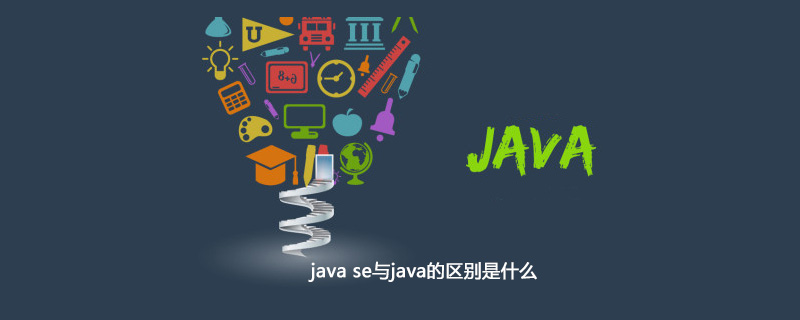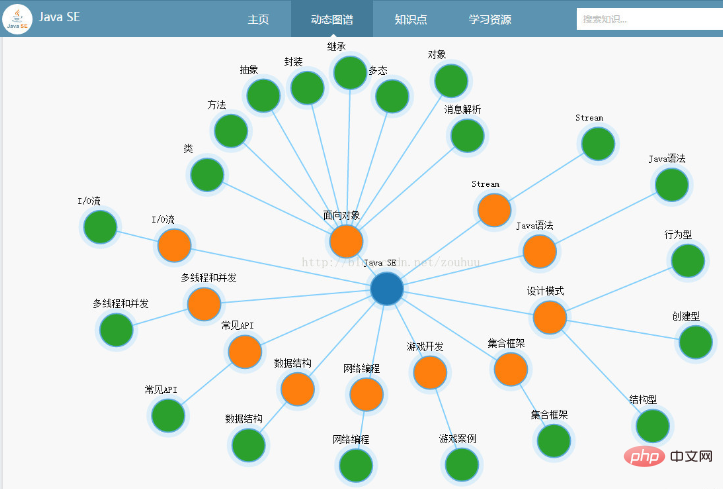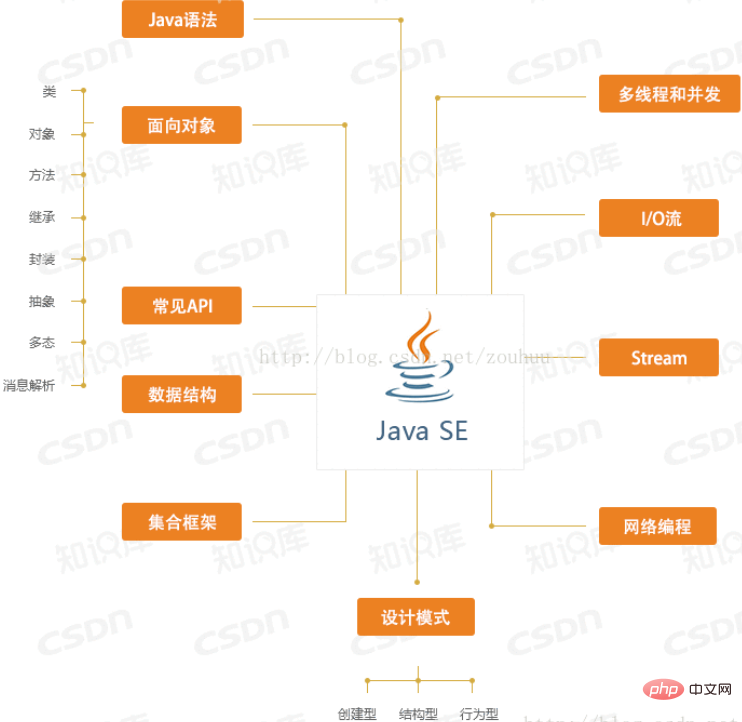What is the difference between java se and java
Nov 14, 2019 pm 01:30 PM
Java is a programming language that has three versions, Java SE (Standard Edition), Java EE (Enterprise Edition) and Java ME (Micro Edition). Java SE is just a specification and framework for programming in Java. It is not a programming language. Java SE (java standard edition) generally includes jdk, jre and various API documents.
Java SE (Java Platform, Standard Edition). Java SE was formerly known as J2SE. It allows the development and deployment of Java applications for use in desktop, server, embedded and real-time environments. Java SE contains classes that support Java Web services development and provides the foundation for Java Platform, Enterprise Edition (Java EE).
Java SE = jdk jre
·jdk is used to develop Java programs;
·jre is used to run java programs;
Java SE is a Java application, a classification, not a software.


Many java training videos, all on the PHP Chinese website, welcome to learn online!
The above is the detailed content of What is the difference between java se and java. For more information, please follow other related articles on the PHP Chinese website!

Hot AI Tools

Undress AI Tool
Undress images for free

Undresser.AI Undress
AI-powered app for creating realistic nude photos

AI Clothes Remover
Online AI tool for removing clothes from photos.

Clothoff.io
AI clothes remover

Video Face Swap
Swap faces in any video effortlessly with our completely free AI face swap tool!

Hot Article

Hot Tools

Notepad++7.3.1
Easy-to-use and free code editor

SublimeText3 Chinese version
Chinese version, very easy to use

Zend Studio 13.0.1
Powerful PHP integrated development environment

Dreamweaver CS6
Visual web development tools

SublimeText3 Mac version
God-level code editing software (SublimeText3)
 VSCode settings.json location
Aug 01, 2025 am 06:12 AM
VSCode settings.json location
Aug 01, 2025 am 06:12 AM
The settings.json file is located in the user-level or workspace-level path and is used to customize VSCode settings. 1. User-level path: Windows is C:\Users\\AppData\Roaming\Code\User\settings.json, macOS is /Users//Library/ApplicationSupport/Code/User/settings.json, Linux is /home//.config/Code/User/settings.json; 2. Workspace-level path: .vscode/settings in the project root directory
 How to handle transactions in Java with JDBC?
Aug 02, 2025 pm 12:29 PM
How to handle transactions in Java with JDBC?
Aug 02, 2025 pm 12:29 PM
To correctly handle JDBC transactions, you must first turn off the automatic commit mode, then perform multiple operations, and finally commit or rollback according to the results; 1. Call conn.setAutoCommit(false) to start the transaction; 2. Execute multiple SQL operations, such as INSERT and UPDATE; 3. Call conn.commit() if all operations are successful, and call conn.rollback() if an exception occurs to ensure data consistency; at the same time, try-with-resources should be used to manage resources, properly handle exceptions and close connections to avoid connection leakage; in addition, it is recommended to use connection pools and set save points to achieve partial rollback, and keep transactions as short as possible to improve performance.
 python itertools combinations example
Jul 31, 2025 am 09:53 AM
python itertools combinations example
Jul 31, 2025 am 09:53 AM
itertools.combinations is used to generate all non-repetitive combinations (order irrelevant) that selects a specified number of elements from the iterable object. Its usage includes: 1. Select 2 element combinations from the list, such as ('A','B'), ('A','C'), etc., to avoid repeated order; 2. Take 3 character combinations of strings, such as "abc" and "abd", which are suitable for subsequence generation; 3. Find the combinations where the sum of two numbers is equal to the target value, such as 1 5=6, simplify the double loop logic; the difference between combinations and arrangement lies in whether the order is important, combinations regard AB and BA as the same, while permutations are regarded as different;
 Mastering Dependency Injection in Java with Spring and Guice
Aug 01, 2025 am 05:53 AM
Mastering Dependency Injection in Java with Spring and Guice
Aug 01, 2025 am 05:53 AM
DependencyInjection(DI)isadesignpatternwhereobjectsreceivedependenciesexternally,promotingloosecouplingandeasiertestingthroughconstructor,setter,orfieldinjection.2.SpringFrameworkusesannotationslike@Component,@Service,and@AutowiredwithJava-basedconfi
 python pytest fixture example
Jul 31, 2025 am 09:35 AM
python pytest fixture example
Jul 31, 2025 am 09:35 AM
fixture is a function used to provide preset environment or data for tests. 1. Use the @pytest.fixture decorator to define fixture; 2. Inject fixture in parameter form in the test function; 3. Execute setup before yield, and then teardown; 4. Control scope through scope parameters, such as function, module, etc.; 5. Place the shared fixture in conftest.py to achieve cross-file sharing, thereby improving the maintainability and reusability of tests.
 How to obtain digital currency BTC? What are the differences between btc and digital currency?
Aug 01, 2025 pm 11:15 PM
How to obtain digital currency BTC? What are the differences between btc and digital currency?
Aug 01, 2025 pm 11:15 PM
There are four main ways to obtain BTC: 1. Register and exchange it with fiat currency or other digital assets through centralized trading platforms such as Binance, OK, Huobi, and Gate.io; 2. Participate in P2P platforms to directly trade with individuals, and pay attention to the credit risks of the counterparty; 3. Provide goods or services to accept BTC as payment; 4. Participate in airdrops, competitions and other platform reward activities to obtain a small amount of BTC. The core difference between BTC and digital currency is: 1. BTC is a type of digital currency, which belongs to a genus relationship; 2. BTC adopts a proof of work (PoW) mechanism, while other digital currencies may use various technologies such as proof of stake (PoS); 3. BTC emphasizes the value storage function of "digital gold", and other digital currencies may focus on payment efficiency or
 How to work with Calendar in Java?
Aug 02, 2025 am 02:38 AM
How to work with Calendar in Java?
Aug 02, 2025 am 02:38 AM
Use classes in the java.time package to replace the old Date and Calendar classes; 2. Get the current date and time through LocalDate, LocalDateTime and LocalTime; 3. Create a specific date and time using the of() method; 4. Use the plus/minus method to immutably increase and decrease the time; 5. Use ZonedDateTime and ZoneId to process the time zone; 6. Format and parse date strings through DateTimeFormatter; 7. Use Instant to be compatible with the old date types when necessary; date processing in modern Java should give priority to using java.timeAPI, which provides clear, immutable and linear
 What is the difference between trading coins and trading stocks? Which one is more risky? Make more money
Jul 31, 2025 pm 08:03 PM
What is the difference between trading coins and trading stocks? Which one is more risky? Make more money
Jul 31, 2025 pm 08:03 PM
The difference between cryptocurrencies and stocks lies in the nature of assets, market mechanisms and risk-return characteristics. 1. Stocks represent corporate ownership, value is based on profits and dividends, regulated and trading time is limited, with an annualized return of about 10%, suitable for medium- and long-term investors; 2. Cryptocurrencies rely on market consensus and technology applications, with 24-hour trading, no limit on fluctuations, and volatility is severe. Bitcoin’s historical average annual return reaches 46.6%, but the drawdown is often more than 80%, which is even higher; 3. Conservative investors should allocate 70-80% stocks 20-30% cryptocurrency fixed investment, and radicals can invest in crypto assets mainly and use stablecoins and AI tools to hedge risks; 4. The optimal strategy in 2025 is to build a combination of "stock ballast (70%) cryptocurrency commando (30%)".






